Abstract
Bovine heart cytochrome c oxidase is an electron-current driven proton pump. To investigate the mechanism by which this pump operates it is important to study individual electron- and proton-transfer reactions in the enzyme, and key reactions in which they are kinetically and thermodynamically coupled. In this work, we have simultaneously measured absorbance changes associated with electron-transfer reactions and conductance changes associated with protonation reactions following pulsed illumination of the photolabile complex of partly reduced bovine cytochrome c oxidase and carbon monoxide. Following CO dissociation, several kinetic phases in the absorbance changes were observed with time constants ranging from approximately 3 microseconds to several milliseconds, reflecting internal electron-transfer reactions within the enzyme. The data show that the rate of one of these electron-transfer reactions, from cytochrome a3 to a on a millisecond time scale, is controlled by a proton-transfer reaction. These results are discussed in terms of a model in which cytochrome a3 interacts electrostatically with a protonatable group, L, in the vicinity of the binuclear center, in equilibrium with the bulk through a proton-conducting pathway, which determines the rate of proton transfer (and indirectly also of electron transfer). The interaction energy of cytochrome a3 with L was determined independently from the pH dependence of the extent of the millisecond-electron transfer and the number of protons released, as determined from the conductance measurements. The magnitude of the interaction energy, 70 meV (1 eV = 1.602 x 10(-19) J), is consistent with a distance of 5-10 A between cytochrome a3 and L. Based on the recently determined high-resolution x-ray structures of bovine and a bacterial cytochrome c oxidase, possible candidates for L and a physiological role for L are discussed.
Full text
PDF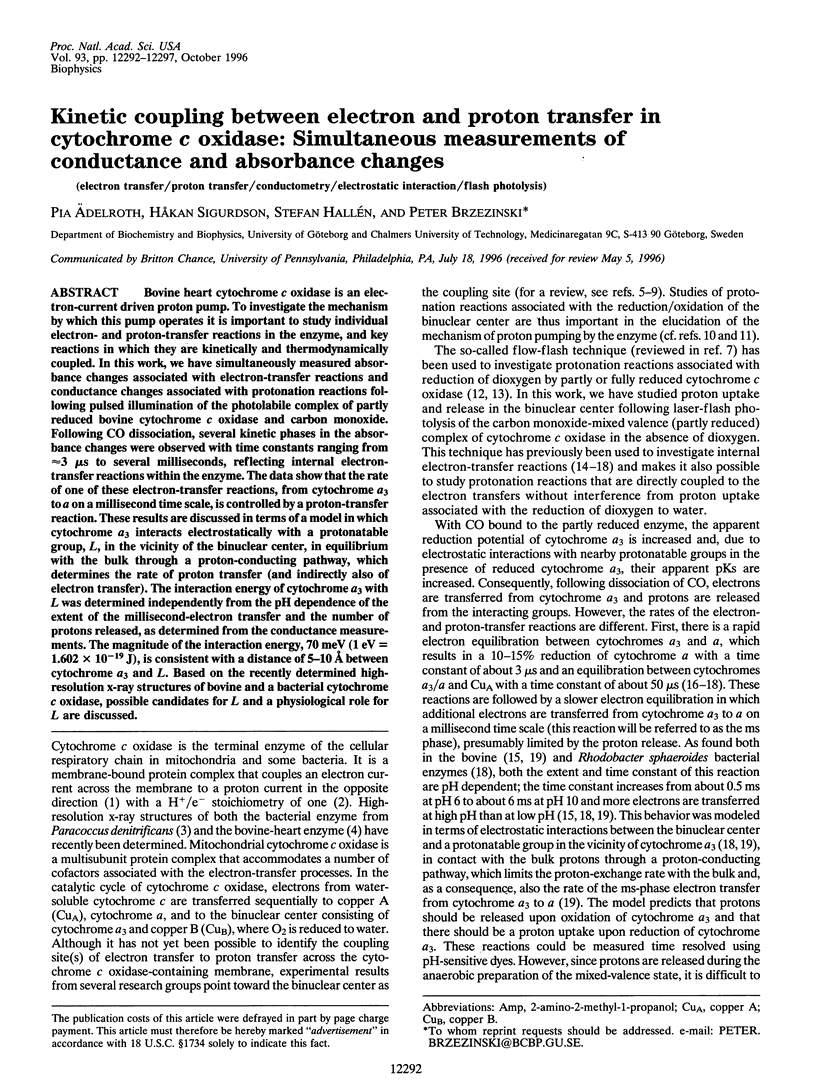
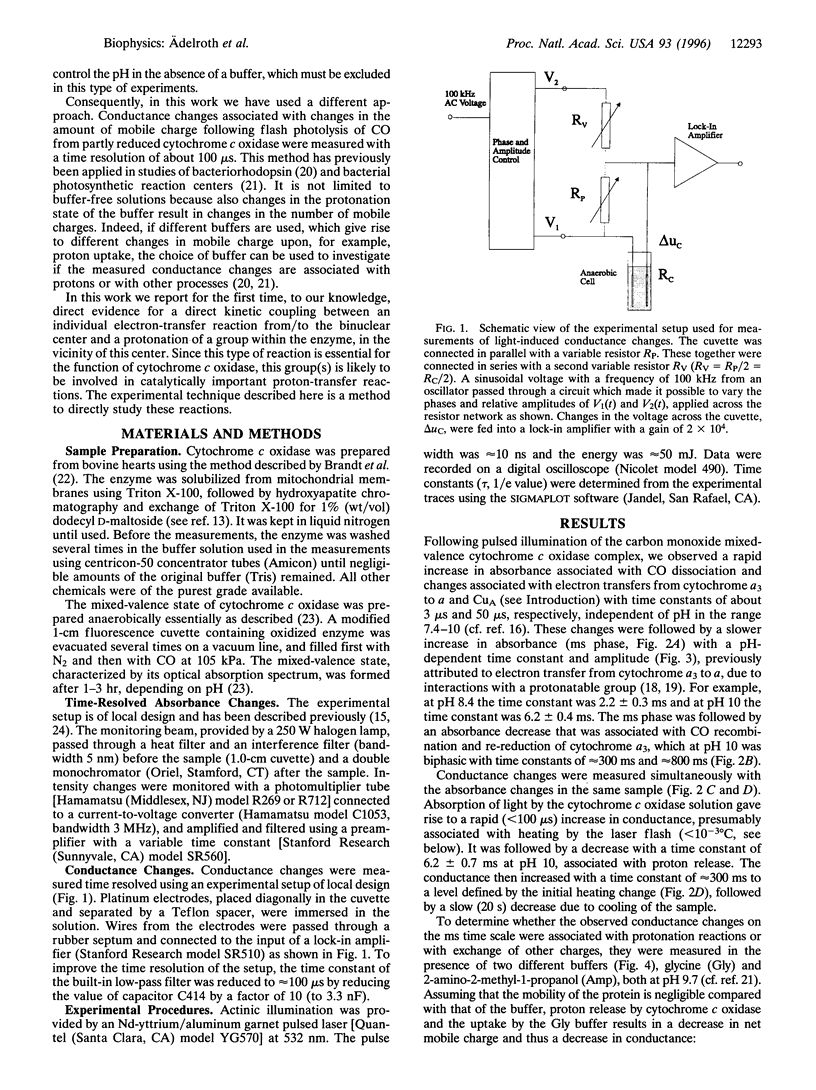
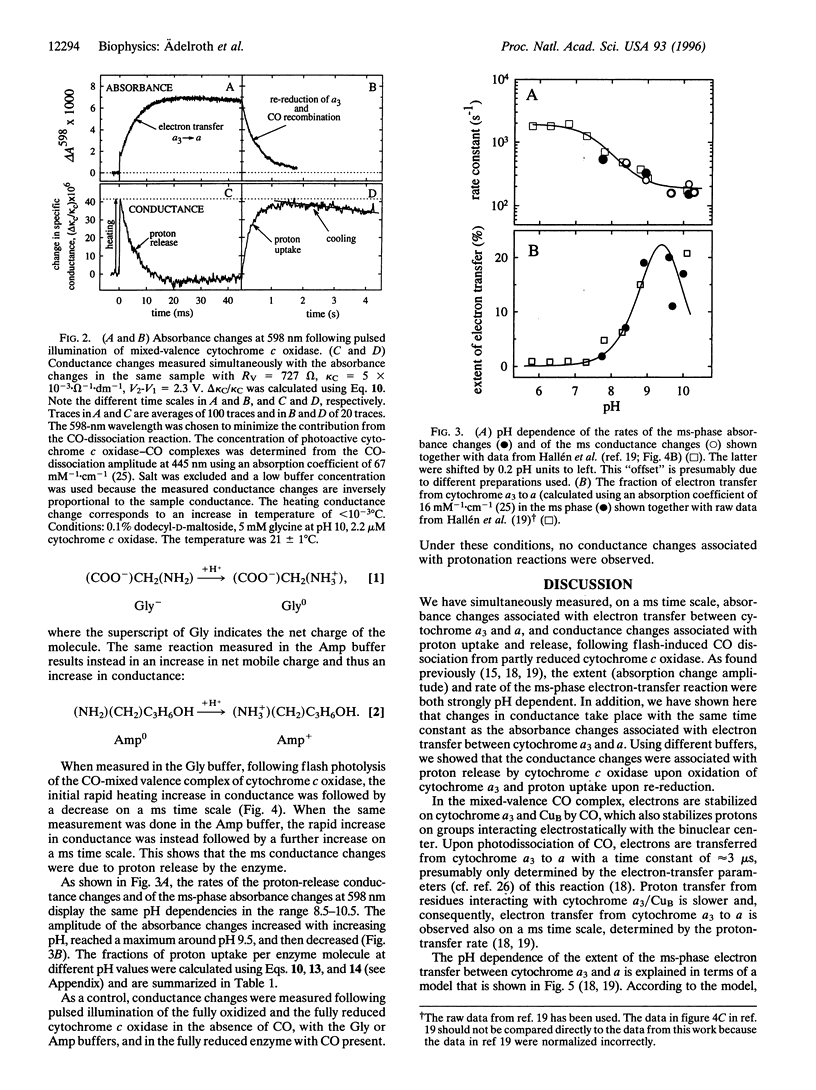
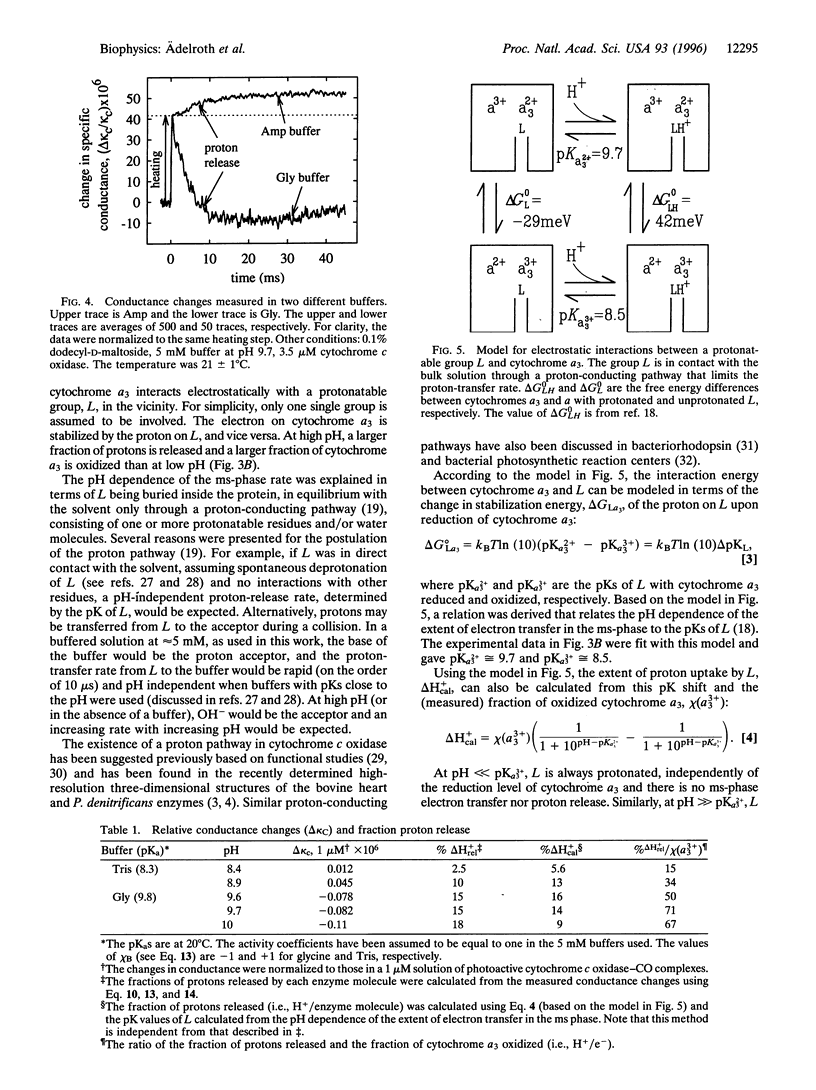
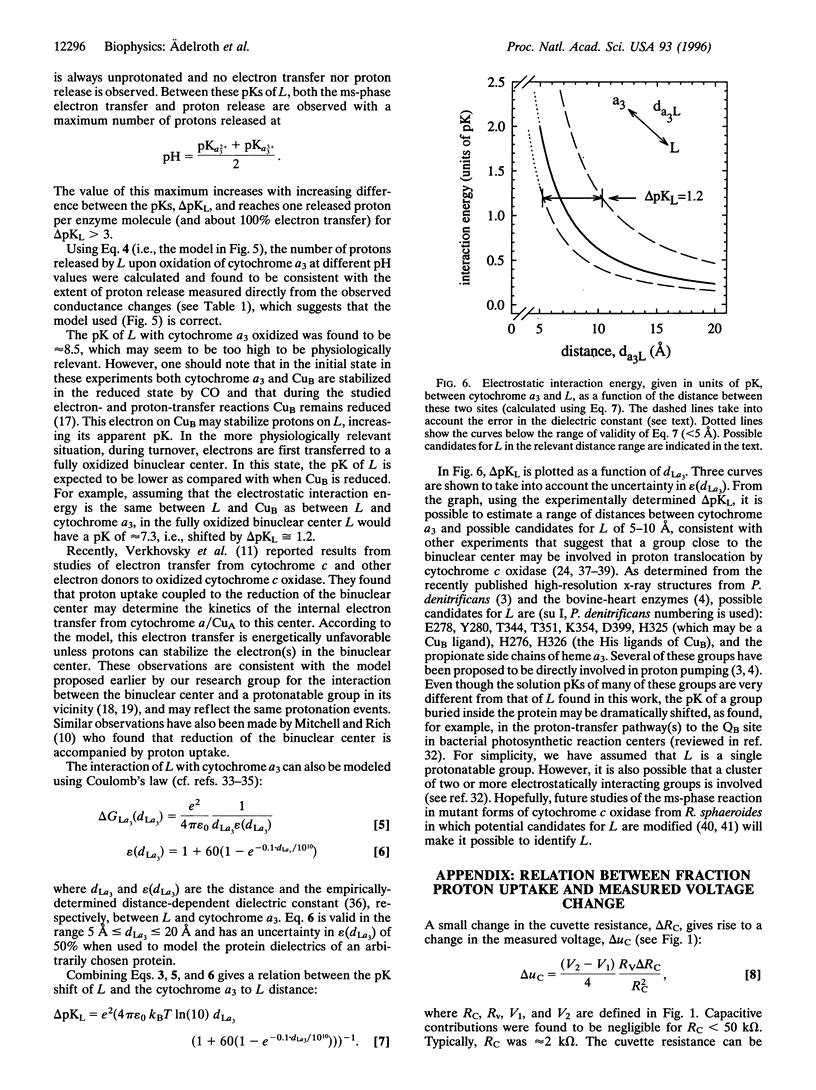
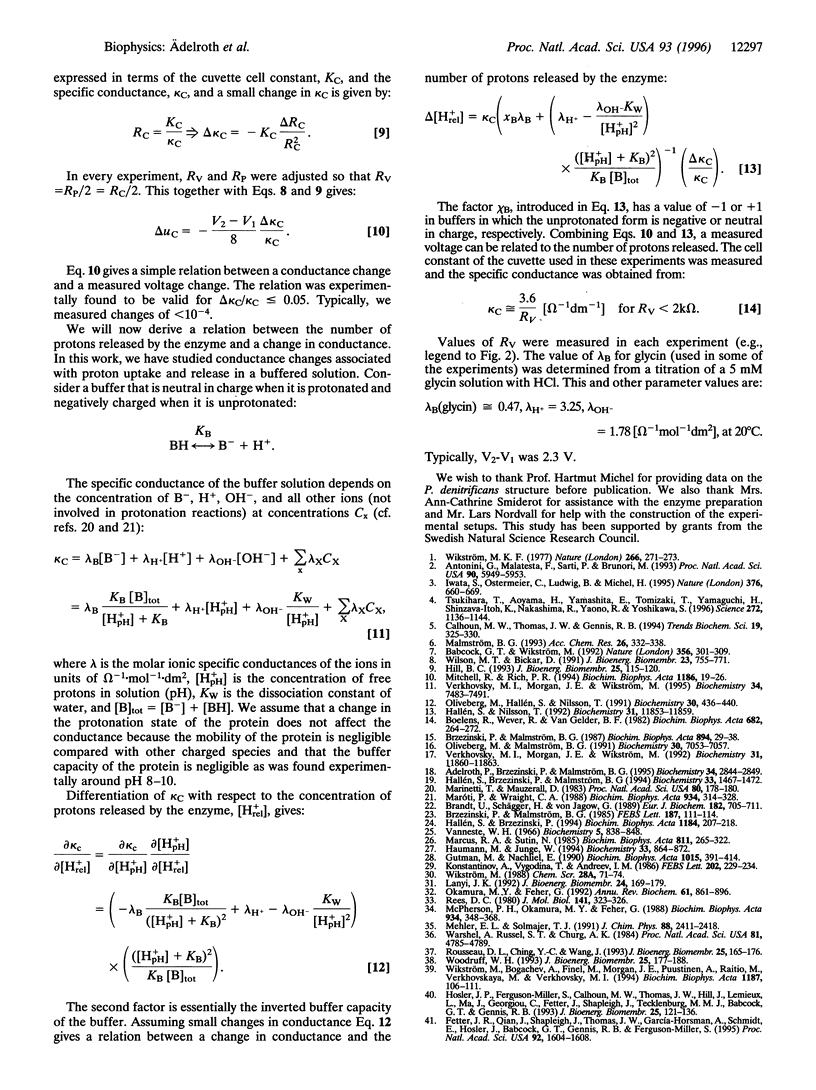
Selected References
These references are in PubMed. This may not be the complete list of references from this article.
- Adelroth P., Brzezinski P., Malmström B. G. Internal electron transfer in cytochrome c oxidase from Rhodobacter sphaeroides. Biochemistry. 1995 Mar 7;34(9):2844–2849. doi: 10.1021/bi00009a014. [DOI] [PubMed] [Google Scholar]
- Antonini G., Malatesta F., Sarti P., Brunori M. Proton pumping by cytochrome oxidase as studied by time-resolved stopped-flow spectrophotometry. Proc Natl Acad Sci U S A. 1993 Jul 1;90(13):5949–5953. doi: 10.1073/pnas.90.13.5949. [DOI] [PMC free article] [PubMed] [Google Scholar]
- Babcock G. T., Wikström M. Oxygen activation and the conservation of energy in cell respiration. Nature. 1992 Mar 26;356(6367):301–309. doi: 10.1038/356301a0. [DOI] [PubMed] [Google Scholar]
- Boelens R., Wever R., Van Gelder B. F. Electron transfer after flash photolysis of mixed-valence carboxycytochrome c oxidase. Biochim Biophys Acta. 1982 Nov 15;682(2):264–272. doi: 10.1016/0005-2728(82)90107-4. [DOI] [PubMed] [Google Scholar]
- Brandt U., Schägger H., von Jagow G. Purification of cytochrome-c oxidase retaining its pulsed form. Eur J Biochem. 1989 Jul 1;182(3):705–711. doi: 10.1111/j.1432-1033.1989.tb14882.x. [DOI] [PubMed] [Google Scholar]
- Brzezinski P., Malmström B. G. The mechanism of electron gating in proton pumping cytochrome c oxidase: the effect of pH and temperature on internal electron transfer. Biochim Biophys Acta. 1987 Oct 29;894(1):29–38. doi: 10.1016/0005-2728(87)90209-x. [DOI] [PubMed] [Google Scholar]
- Brzezinski P., Malmström B. G. The reduction of cytochrome c oxidase by carbon monoxide. FEBS Lett. 1985 Jul 22;187(1):111–114. doi: 10.1016/0014-5793(85)81224-2. [DOI] [PubMed] [Google Scholar]
- Calhoun M. W., Thomas J. W., Gennis R. B. The cytochrome oxidase superfamily of redox-driven proton pumps. Trends Biochem Sci. 1994 Aug;19(8):325–330. doi: 10.1016/0968-0004(94)90071-x. [DOI] [PubMed] [Google Scholar]
- Fetter J. R., Qian J., Shapleigh J., Thomas J. W., García-Horsman A., Schmidt E., Hosler J., Babcock G. T., Gennis R. B., Ferguson-Miller S. Possible proton relay pathways in cytochrome c oxidase. Proc Natl Acad Sci U S A. 1995 Feb 28;92(5):1604–1608. doi: 10.1073/pnas.92.5.1604. [DOI] [PMC free article] [PubMed] [Google Scholar]
- Hallén S., Brzezinski P. Light-induced structural changes in cytochrome c oxidase: implication for the mechanism of electron and proton gating. Biochim Biophys Acta. 1994 Mar 8;1184(2-3):207–218. doi: 10.1016/0005-2728(94)90225-9. [DOI] [PubMed] [Google Scholar]
- Hallén S., Brzezinski P., Malmström B. G. Internal electron transfer in cytochrome c oxidase is coupled to the protonation of a group close to the bimetallic site. Biochemistry. 1994 Feb 15;33(6):1467–1472. doi: 10.1021/bi00172a024. [DOI] [PubMed] [Google Scholar]
- Hallén S., Nilsson T. Proton transfer during the reaction between fully reduced cytochrome c oxidase and dioxygen: pH and deuterium isotope effects. Biochemistry. 1992 Dec 1;31(47):11853–11859. doi: 10.1021/bi00162a025. [DOI] [PubMed] [Google Scholar]
- Haumann M., Junge W. Extent and rate of proton release by photosynthetic water oxidation in thylakoids: electrostatic relaxation versus chemical production. Biochemistry. 1994 Feb 1;33(4):864–872. doi: 10.1021/bi00170a003. [DOI] [PubMed] [Google Scholar]
- Hill B. C. The sequence of electron carriers in the reaction of cytochrome c oxidase with oxygen. J Bioenerg Biomembr. 1993 Apr;25(2):115–120. doi: 10.1007/BF00762853. [DOI] [PubMed] [Google Scholar]
- Hosler J. P., Ferguson-Miller S., Calhoun M. W., Thomas J. W., Hill J., Lemieux L., Ma J., Georgiou C., Fetter J., Shapleigh J. Insight into the active-site structure and function of cytochrome oxidase by analysis of site-directed mutants of bacterial cytochrome aa3 and cytochrome bo. J Bioenerg Biomembr. 1993 Apr;25(2):121–136. doi: 10.1007/BF00762854. [DOI] [PubMed] [Google Scholar]
- Iwata S., Ostermeier C., Ludwig B., Michel H. Structure at 2.8 A resolution of cytochrome c oxidase from Paracoccus denitrificans. Nature. 1995 Aug 24;376(6542):660–669. doi: 10.1038/376660a0. [DOI] [PubMed] [Google Scholar]
- Konstantinov A., Vygodina T., Andreev I. M. Electrogenic proton exchange between cytochrome a3 active center and M-aqueous phase. Evidence for cytochrome a3-associated input proton well. FEBS Lett. 1986 Jul 7;202(2):229–234. doi: 10.1016/0014-5793(86)80692-5. [DOI] [PubMed] [Google Scholar]
- Lanyi J. K. Proton transfer and energy coupling in the bacteriorhodopsin photocycle. J Bioenerg Biomembr. 1992 Apr;24(2):169–179. doi: 10.1007/BF00762675. [DOI] [PubMed] [Google Scholar]
- Marinetti T., Mauzerall D. Absolute quantum yields and proof of proton and nonproton transient release and uptake in photoexcited bacteriorhodopsin. Proc Natl Acad Sci U S A. 1983 Jan;80(1):178–180. doi: 10.1073/pnas.80.1.178. [DOI] [PMC free article] [PubMed] [Google Scholar]
- Mitchell R., Rich P. R. Proton uptake by cytochrome c oxidase on reduction and on ligand binding. Biochim Biophys Acta. 1994 Jun 28;1186(1-2):19–26. doi: 10.1016/0005-2728(94)90130-9. [DOI] [PubMed] [Google Scholar]
- Okamura M. Y., Feher G. Proton transfer in reaction centers from photosynthetic bacteria. Annu Rev Biochem. 1992;61:861–896. doi: 10.1146/annurev.bi.61.070192.004241. [DOI] [PubMed] [Google Scholar]
- Oliveberg M., Hallén S., Nilsson T. Uptake and release of protons during the reaction between cytochrome c oxidase and molecular oxygen: a flow-flash investigation. Biochemistry. 1991 Jan 15;30(2):436–440. doi: 10.1021/bi00216a019. [DOI] [PubMed] [Google Scholar]
- Oliveberg M., Malmström B. G. Internal electron transfer in cytochrome c oxidase: evidence for a rapid equilibrium between cytochrome a and the bimetallic site. Biochemistry. 1991 Jul 23;30(29):7053–7057. doi: 10.1021/bi00243a003. [DOI] [PubMed] [Google Scholar]
- Rees D. C. Experimental evaluation of the effective dielectric constant of proteins. J Mol Biol. 1980 Aug 15;141(3):323–326. doi: 10.1016/0022-2836(80)90184-9. [DOI] [PubMed] [Google Scholar]
- Rousseau D. L., Ching Y., Wang J. Proton translocation in cytochrome c oxidase: redox linkage through proximal ligand exchange on cytochrome a3. J Bioenerg Biomembr. 1993 Apr;25(2):165–176. doi: 10.1007/BF00762858. [DOI] [PubMed] [Google Scholar]
- Tsukihara T., Aoyama H., Yamashita E., Tomizaki T., Yamaguchi H., Shinzawa-Itoh K., Nakashima R., Yaono R., Yoshikawa S. The whole structure of the 13-subunit oxidized cytochrome c oxidase at 2.8 A. Science. 1996 May 24;272(5265):1136–1144. doi: 10.1126/science.272.5265.1136. [DOI] [PubMed] [Google Scholar]
- Vanneste W. H. The stoichiometry and absorption spectra of components a and a-3 in cytochrome c oxidase. Biochemistry. 1966 Mar;5(3):838–848. doi: 10.1021/bi00867a005. [DOI] [PubMed] [Google Scholar]
- Verkhovsky M. I., Morgan J. E., Wikström M. Control of electron delivery to the oxygen reduction site of cytochrome c oxidase: a role for protons. Biochemistry. 1995 Jun 6;34(22):7483–7491. doi: 10.1021/bi00022a023. [DOI] [PubMed] [Google Scholar]
- Verkhovsky M. I., Morgan J. E., Wikström M. Intramolecular electron transfer in cytochrome c oxidase: a cascade of equilibria. Biochemistry. 1992 Dec 1;31(47):11860–11863. doi: 10.1021/bi00162a026. [DOI] [PubMed] [Google Scholar]
- Warshel A., Russell S. T., Churg A. K. Macroscopic models for studies of electrostatic interactions in proteins: limitations and applicability. Proc Natl Acad Sci U S A. 1984 Aug;81(15):4785–4789. doi: 10.1073/pnas.81.15.4785. [DOI] [PMC free article] [PubMed] [Google Scholar]
- Wikstrom M. K. Proton pump coupled to cytochrome c oxidase in mitochondria. Nature. 1977 Mar 17;266(5599):271–273. doi: 10.1038/266271a0. [DOI] [PubMed] [Google Scholar]
- Wikström M., Bogachev A., Finel M., Morgan J. E., Puustinen A., Raitio M., Verkhovskaya M., Verkhovsky M. I. Mechanism of proton translocation by the respiratory oxidases. The histidine cycle. Biochim Biophys Acta. 1994 Aug 30;1187(2):106–111. doi: 10.1016/0005-2728(94)90093-0. [DOI] [PubMed] [Google Scholar]
- Wilson M. T., Bickar D. Cytochrome oxidase as a proton pump. J Bioenerg Biomembr. 1991 Oct;23(5):755–771. doi: 10.1007/BF00786000. [DOI] [PubMed] [Google Scholar]
- Woodruff W. H. Coordination dynamics of heme-copper oxidases. The ligand shuttle and the control and coupling of electron transfer and proton translocation. J Bioenerg Biomembr. 1993 Apr;25(2):177–188. doi: 10.1007/BF00762859. [DOI] [PubMed] [Google Scholar]


